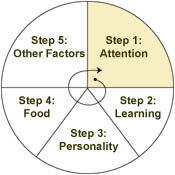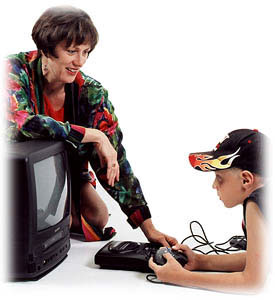|
Welcome to Step One! The
focus is: Attention
 The purpose of Step One is to find out:
The purpose of Step One is to find out:

|
if there is a concern in the area of attention |

|
how the attention challenges affect you
and what to do about them |

- Fill out the Screening
Checklist for Attentional Concerns.
- Decide if you have concerns
in this area. If not, go to Step Two-Learning. If you think you
have concerns continue with Step One.
- Fill out the Levine Information
Processing Questionnaire.
- See Strategies for
Improving Attention.
- Do the Self-Evaluation.
- Go to Step
Two - Learning.
1. Fill out Screening Checklist for Attentional Concerns
a) To find out if you have attentional difficulties,
download the Screening
Checklist for Attentional Concerns and print it.
b) Make a list of interests and hobbies that give you pleasure and then make a list of activities (such as household chores) that you do not enjoy doing. Do not include academic studies or work-related activities. Write these on your Journey Circle in the Attention section
c) Fill out the Screening Checklist (SC/A) twice - once for how you are when interested in something and once for activities where you are not particularly interested. Have another person who knows you well fill the SC/A out too on a separate checklist. Use a checkmark when thinking about what you love and a circle when thinking about how you are when doing things you do not enjoy.

2. Decide if you have concerns in this area. If not, go to Step
Two-Learning. If you think you have concerns continue with Step
One.
a) Look at the Screening Checklist that describes
your attentional symptoms when you are not particularly interested.
Do you have 4 to 5 checkmarks in the Pretty Much or Very Much
columns? Yes or No?
 If
NO, this means that you probably do not have concerns in this
area. Proceed to Step Two - Learning. If
NO, this means that you probably do not have concerns in this
area. Proceed to Step Two - Learning.
 If
YES, this means that there are concerns in this area. What we
do NOT yet know is the cause of your attentional symptoms. If
YES, this means that there are concerns in this area. What we
do NOT yet know is the cause of your attentional symptoms.

3. Fill out the Levine Information Processing Questionnaire
a) Download: Levine
Information Processing Questionnaire and print it.
b) Have yourself and your helper complete the questionnaire and
then score it according to the instructions on the final page.
c) Put a star beside the 4-6 areas with the most checkmarks. This
tells you how your mind is affected by your attentional concerns.
Consider this part of your Owner's Manual - an awareness of how
you work.

4. See Strategies for Improving Attention
a) Download the Strategies
for Improving Attention.
b) Put a star beside the 4-6 areas identified in the Levine Information
Processing Questionnaire. You can use these strategies now or
refer to them later. I recommend getting through the five steps
and then coming back to have a look at these areas after you have
finished your Self-Managed Journey, if attention is still a concern.
c) When you are ready to try some of these strategies, pick one
area that you'd like to work on, then select a strategy that appeals
to you. Try it out for three weeks and see how it works.

5. Do the Self-Evaluation.
Our Goal was to see:

|
if there is a concern in the area of
attention |

|
how the attention challenges affect
you and what to do about them |
Did you have a concern in Attention?
Yes or No?
 If
YES, did you find out how it affects you? Yes or No? If
YES, did you find out how it affects you? Yes or No?
 If
YES, great. I suggest that you realize that this is how you
are "wired". If
YES, great. I suggest that you realize that this is how you
are "wired".
 If
NO, go back and review the Levine Information
Processing Questionnaire If
NO, go back and review the Levine Information
Processing Questionnaire
 If
NO, then you went to Step Two
- Learning. If
NO, then you went to Step Two
- Learning.
Did you learn what to do about it?
Yes or No?
 If
YES, great. If
YES, great.
 If
NO, go back and review Strategies for
Improving Attention in Step One - Attention. Work on one
area at a time. Apply one strategy for several weeks and see
how it works. If it works, wonderful, if not, try another strategy. If
NO, go back and review Strategies for
Improving Attention in Step One - Attention. Work on one
area at a time. Apply one strategy for several weeks and see
how it works. If it works, wonderful, if not, try another strategy.
 Remember that you are the expert on yourself! Do what makes sense
to you. Remember that you are the expert on yourself! Do what makes sense
to you.

5. Now it is time to proceed: Go to Step
Two - Learning.
   
Q1: Why are we looking at Attention?
A: Many
people are unaware that they have attention barriers that are
preventing them from being the best they can be.
Q2: What if my child or I already have been diagnosed with AD/HD?
A:
In my experience, it is easy to be misdiagnosed with AD/HD (Attention
Deficit/Hyperactivity Disorder). Therefore, even if you already
have a diagnosis, I encourage you to go through the whole Self-Managed
Journey. If you still have attentional symptoms at the end of
the Self-Managed Journey, then it is likely that your diagnosis
for AD/HD was correct. Wherever you are in the diagnostic process,
you will learn more about yourself, find out strategies to help
you address common challenges, and learn about medical and natural
interventions.
Q3: How do we avoid or get rid of side effects from medication for
AD/HD?
A: The
Farrelly
Protocol is a very prudent method with which to conduct a
medication trial. In my experience, side effects with medication
seem to be due most often to overmedication. I also see side-effects
when the attentional symptoms are due to food sensitivities rather
than real AD/HD. Once you have gone through all the steps in the
Self-managed Journey, if you still have symptoms of AD/HD, I urge
you to take a copy of the Farrelly Protocol to your family physician
and discuss the option of trying it to see if it or an adaptation
of it will reduce the side effects from the medication.
Q4: How can I find out if I have AD/HD?
A: REMINDER:
There can be many causes of attentional symptoms. Some of these
include: stress, depression, post-traumatic stress disorder, thyroid,
hypoglycemia, hearing, vision, allergies, abuse (physical, sexual,
emotional, drug or alcohol) or a chaotic environment. I have named
only a few possible reasons. It is beyond the scope of this self-assessment
to be able to rule out all of these, or to make a diagnosis of
AD/HD. After dealing with your attentional symptoms through the
Self-Managed Journey it is advisable to seek additional help for
any of these other concerns.
 More questions? We're Here to Help More questions? We're Here to Help
If not, see Step
Two - Learning
   

Welcome | Self-Managed
Journey | Resources | Useful
Links | About Dr. Teeya | Contact
Us
Notices and Legal Disclaimer
Copyright 2025, Vivid Psychology Inc. All rights reserved
|



 The purpose of Step One is to find out:
The purpose of Step One is to find out: